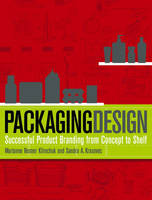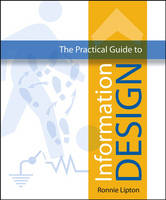Packaging Design
 -15%
portes grátis
-15%
portes grátis
Packaging Design
Successful Product Branding from Concept to Shelf
Klimchuk, Marianne R.; Krasovec, Sandra A.
John Wiley & Sons Inc
09/2006
224
Dura
Inglês
9780471720164
047172016X
15 a 20 dias
783
Packaging Design: From Concept to Shelf offers a single source for practical information on how to create successful packaging designs that serve as the marketing vehicle for consumer products.
Acknowledgments. Foreword. Preface. Chapter 1: Accounting For the Past. Developments through Emerging Societies. Capitalism through the Ages. History of Writing. Printing . The Beginnings of Visual Communication. Industrialization. Early Branding. Lithography. The New Economy. Twentieth-Century Developments. The Growth of the Packaging Design Business. Consumer Protection. Advancements in Packaging Design. Ending a Century. Design Today. Chapter 2: Defining Packaging Design. Packaging Design as Communication. Packaging Design in the Marketing Mix. Reaching the Target Market. Proprietary Features. Packaging Design and the Brand. Brand Evolution. Brand Identity. Brand Promise. Brand Equity. Brand Loyalty. Brand Repositioning. Brand Extension. Packaging Design and Society. Packaging Design Objectives. Chapter 3: The Stakeholders. The Stakeholders in Packaging Design. Professional Roles. Checklist of What Every Designer Needs to Know. Strategic Services. Consumer Product Categories. Professional Profi les. Lisa Francella. Debbie Millman. Dean Lindsay. Adrienne Muken. Jason Lombardo. Carson Ahlman. Chapter 4: Design Fundamentals. Basic Design Principles. Packaging Design Principles. The Primary Display Panel. The Well-Designed PDP. Chapter 5: Typography. Typography and Packaging Design. Categories of Type. Typography and Technology. Typography and Kerning. Typographic Principles for Packaging Design. Designing the Brand Identity. Key Points about Typography. Chapter 6: Communicating With Color. Basics of Color. Color Terminology. Color Distinguishes the Packaging Design. Color Associations Vary. Brand Building and Color. Owning Color in Packaging Design. Color Forecasting and Trends. Color on the Computer Screen. Packaging Design and Color in Retail. Key Points about Color. Chapter 7: Communicating With Imagery. Imagery and Cultural Perception. Effective Uses of Imagery. Illustration and Photography as Mediums for Imagery. Appetite Appeal. Cropping and Scaling Images. Instructional Illustration. Characters. Graphic Devices. Symbols and Icons. Violators. Key Points about Imagery. Chapter 8: Structures and Materials. Structures and Materials in Packaging Design. Paperboard. Corrugated Paperboard. Folding Cartons. Folding Carton Styles. Set-Up Boxes. Canisters. Other Paper and Paperboard Structures. Plastics. Blister Packs. Glass. Metal. Cans. Tubes. Flexible Packaging. Labels. Closures. Stock Packaging. Structural Design. Model Making. Rapid Prototyping. New Material Technologies. Key Points about Structures and Materials. Chapter 9: Planning for Production. Design Considerations for Materials and Production. Understanding Technology. File Management. Art Files: Image vs. Vector . File Naming. The Packaging Die. The Packaging Mechanical. File Delivery and Pre-Flight. Digital Work Flow. Color and Printing. Color Management. Printing Processes. Special Processes and Techniques. Production Follow-Through. Key Points about Production. Chapter 10: The Design Process. The Marketing Brief. Request for Proposals (RFP). The Design Proposal. Determining Fees. Agreement of Terms. Beginning the Assignment. Phase 1: Research and Analysis. Category Analysis. Product Analysis. Brand Name. Name Generation. Visual References or "Swipes." Concept Boards. Phase 2: Preliminary Design. Beginning a Design Strategy. Brainstorming and Ideation Sessions. Concepts and Strategies. Sketching in Black and White. Logotype Development. Thumbnail Development. Initial Layouts. Visual Hierarchy. Design Reviews and Presentations. Phase 3: Design Development. General Guidelines for Net Weight or Product Contents. Comprehensives. Research. Phase 4: Final Design Refi nement. Billboard. Phase 5: Pre-Production and Digital Mechanicals. Production Checklist. Key Points about the Design Process. Chapter 11: Considering the Environment. The Three "R's." Packaging and Life-Cycle Assessment. The LCA Process. Environmental Factors. Source Reduction. Waste Management. Creating Change. Key Points about the Environment. Chapter 12: Understanding Legal Issues. Understanding Legal Issues. Laws and Regulatory Agencies. Excerpts from the FDA Food Labeling Guide. FDA Additional Points. FDA Terminology. Intellectual Property Rights. Counterfeiting and Packaging Design. Key Points about Legal Issues. APPENDIX A: Creating a Folding Carton Comp. APPENDIX B: Packaging Design Portfolio. APPENDIX C: Professional Sources. Bibliography. Glossary. Index.
Este título pertence ao(s) assunto(s) indicados(s). Para ver outros títulos clique no assunto desejado.
Packaging Design: From Concept to Shelf offers a single source for practical information on how to create successful packaging designs that serve as the marketing vehicle for consumer products.
Acknowledgments. Foreword. Preface. Chapter 1: Accounting For the Past. Developments through Emerging Societies. Capitalism through the Ages. History of Writing. Printing . The Beginnings of Visual Communication. Industrialization. Early Branding. Lithography. The New Economy. Twentieth-Century Developments. The Growth of the Packaging Design Business. Consumer Protection. Advancements in Packaging Design. Ending a Century. Design Today. Chapter 2: Defining Packaging Design. Packaging Design as Communication. Packaging Design in the Marketing Mix. Reaching the Target Market. Proprietary Features. Packaging Design and the Brand. Brand Evolution. Brand Identity. Brand Promise. Brand Equity. Brand Loyalty. Brand Repositioning. Brand Extension. Packaging Design and Society. Packaging Design Objectives. Chapter 3: The Stakeholders. The Stakeholders in Packaging Design. Professional Roles. Checklist of What Every Designer Needs to Know. Strategic Services. Consumer Product Categories. Professional Profi les. Lisa Francella. Debbie Millman. Dean Lindsay. Adrienne Muken. Jason Lombardo. Carson Ahlman. Chapter 4: Design Fundamentals. Basic Design Principles. Packaging Design Principles. The Primary Display Panel. The Well-Designed PDP. Chapter 5: Typography. Typography and Packaging Design. Categories of Type. Typography and Technology. Typography and Kerning. Typographic Principles for Packaging Design. Designing the Brand Identity. Key Points about Typography. Chapter 6: Communicating With Color. Basics of Color. Color Terminology. Color Distinguishes the Packaging Design. Color Associations Vary. Brand Building and Color. Owning Color in Packaging Design. Color Forecasting and Trends. Color on the Computer Screen. Packaging Design and Color in Retail. Key Points about Color. Chapter 7: Communicating With Imagery. Imagery and Cultural Perception. Effective Uses of Imagery. Illustration and Photography as Mediums for Imagery. Appetite Appeal. Cropping and Scaling Images. Instructional Illustration. Characters. Graphic Devices. Symbols and Icons. Violators. Key Points about Imagery. Chapter 8: Structures and Materials. Structures and Materials in Packaging Design. Paperboard. Corrugated Paperboard. Folding Cartons. Folding Carton Styles. Set-Up Boxes. Canisters. Other Paper and Paperboard Structures. Plastics. Blister Packs. Glass. Metal. Cans. Tubes. Flexible Packaging. Labels. Closures. Stock Packaging. Structural Design. Model Making. Rapid Prototyping. New Material Technologies. Key Points about Structures and Materials. Chapter 9: Planning for Production. Design Considerations for Materials and Production. Understanding Technology. File Management. Art Files: Image vs. Vector . File Naming. The Packaging Die. The Packaging Mechanical. File Delivery and Pre-Flight. Digital Work Flow. Color and Printing. Color Management. Printing Processes. Special Processes and Techniques. Production Follow-Through. Key Points about Production. Chapter 10: The Design Process. The Marketing Brief. Request for Proposals (RFP). The Design Proposal. Determining Fees. Agreement of Terms. Beginning the Assignment. Phase 1: Research and Analysis. Category Analysis. Product Analysis. Brand Name. Name Generation. Visual References or "Swipes." Concept Boards. Phase 2: Preliminary Design. Beginning a Design Strategy. Brainstorming and Ideation Sessions. Concepts and Strategies. Sketching in Black and White. Logotype Development. Thumbnail Development. Initial Layouts. Visual Hierarchy. Design Reviews and Presentations. Phase 3: Design Development. General Guidelines for Net Weight or Product Contents. Comprehensives. Research. Phase 4: Final Design Refi nement. Billboard. Phase 5: Pre-Production and Digital Mechanicals. Production Checklist. Key Points about the Design Process. Chapter 11: Considering the Environment. The Three "R's." Packaging and Life-Cycle Assessment. The LCA Process. Environmental Factors. Source Reduction. Waste Management. Creating Change. Key Points about the Environment. Chapter 12: Understanding Legal Issues. Understanding Legal Issues. Laws and Regulatory Agencies. Excerpts from the FDA Food Labeling Guide. FDA Additional Points. FDA Terminology. Intellectual Property Rights. Counterfeiting and Packaging Design. Key Points about Legal Issues. APPENDIX A: Creating a Folding Carton Comp. APPENDIX B: Packaging Design Portfolio. APPENDIX C: Professional Sources. Bibliography. Glossary. Index.
Este título pertence ao(s) assunto(s) indicados(s). Para ver outros títulos clique no assunto desejado.





